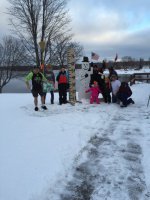You are using an out of date browser. It may not display this or other websites correctly.
You should upgrade or use an alternative browser.
You should upgrade or use an alternative browser.
Team Hennessey did the Hiekki Lunta dance at Krupps today
- Thread starter scottiking
- Start date
groomerdriver
New member
Whut, you don't know Heikki Lunta?Not sure what a Heiikie [sic] Lunta Dance is,, but looks good
- Read all about Heikki here: (click →) Heikki Lunta - A Modern Copper Country Folk Hero.
- See also (click →) Wikipedia: Heikki Lunta.
- See also (click →) Heikki Lunta, (COPYRIGHT:© Hilary Virtanen 2006, quoted here, in part):
Finnish culture was regarded to be as exotic as their assumed racial origins, with their use of the sauna bath seen as unseemly, immoral, and possibly supernatural behavior. Contributing also to imbalanced imagery of Finns was their tradition of the noita. As folklorist Richard Dorson described in his 1952 book on Upper Michigan folklore, Bloodstoppers and Bearwalkers,
“The noita, variously described as a religious magician, a wizard, or a healer,played a prominent role in village life. He cured the sick, with or without herbs,charmed and cursed evildoers, and on special occasions used his powers to defend his people from the enemy and so became a national folk hero.”
The noita is one of the last glimmers of Finnish shamanism, and as such, is a powerful symbol of Finnish indigenous culture. In a 2004 interview, Dave Riutta stated that Heikki Lunta was inspired in part by the stereotype of the Native American “rain dance,” but he, and numerous others in the ethnic community have also acknowledged these obvious ties to Finnish cultural imagery. Robert Glantz, in an article for the Finnish-American Reporter, directly addresses this connection: “Unconsciously perhaps, composer Riutta tapped into the archaic pulse of pagan Finland, the shamanistic rhythm of the Kalevala, to empower his Heikki Lunta with a blue-eyed mojo, capable of moving the heavens to snow.”
Adding to this picture was the fact that Finnish language does not belong to the Indo-European language family, making their language just as strange and exotic as their customs, and so Finns were further marginalized from other immigrant groups. Creating communities in which their language and traditions could continue to exist, Finns have maintained a strong sense of identity through to the present generation of youth. While certain elements of the immigrant culture have ceased to exist, or have radically changed, Finnish-American ties to their heritage culture have resulted in a strong sense of tradition as evidenced in foodways, vernacular architecture, religion, and language.
"Tulepa Heikki-poika tanssimaan, täällä lisää lunta tarvitaan." ("Come along Heikki boy to dance, here more snow is needed.")
Last edited:
krupps_resort
New member
This dance has worked the last 2 years and we're hoping it works again. We sure had a lot of fun. We can do a rerun if we have to.- Get those sleds ready to come to the UP and have a great time-ride safe.
krupps_resort
New member
Also dancing were Mike Sabo, Pres of Superior Snowmobile Club and Richard Krupp. One of our dedicated groomer drivers, Jack Swift was operating the Heikki Lunta Music. Mable the bear even took part for the 3rd year. Today we were going to have a humungous bon fire but wind is not cooperating. We won't complain on that though as long as the wind brings in the snow. Would sure like to have enough by Dec. 1, to get out there to start "panking" it down. Let's get this season started. Mother Nature, we'd like snow from December 1, 2015 to April 1, 2016


